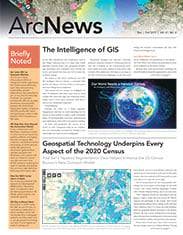In the United States, to ensure that people with disabilities can successfully use technology, Section 508 of the Rehabilitation Act of 1973 requires that federal agencies develop, maintain, and use information and communications technology (ICT) that is accessible to people with disabilities. The guidelines encompass both hardware and software, urging the use of closed captioning for videos, for example, and having proper color contrast on web pages to increase readability.
Focusing on providing good product design and user-friendly features, Esri strives to improve accessibility to its software in accordance with Section 508 guidelines.
“At Esri, our goal is to make GIS accessible to everyone,” said Dirk Gorter, Esri’s director of product management. “To that end, we design and implement our GIS products to be accessible to people regardless of their abilities.”
A Comprehensive Accessibility Strategy
In addition to adhering to Section 508 guidelines for US users, Esri complies with Web Content Accessibility Guidelines (WCAG) for international customers with regard to both product development and maintenance. To increase accessibility, Esri supports the accessibility tools provided by standard operating systems, such as Microsoft Windows, and builds special capabilities into GIS functions across its entire product line.
Esri’s comprehensive accessibility strategy includes the following:
- Develop products, technologies, and services that are accessible and usable by as many people as possible.
- Leverage accessibility technologies available in operating systems, web servers, and database management systems (DBMSs) when and where appropriate.
- Develop GIS-specific accessibility technologies to enable all people to use and apply GIS.
- Empower customers to make informed choices about the Esri products they use by disclosing the products’ accessibility capabilities.
Accessibility Starts with Software Design
At Esri, the inclusion of accessibility-friendly features begins with the software design and redesign processes. A team of user interface and user experience (UI/UX) specialists works with the development group—which includes Esri’s product management, product engineering, and software development teams—to ensure that accessibility is built into new products from the start.
Esri staff receive training and resources to guide them during the design process so they can ensure that their products meet compliance standards. For example, ArcGIS Desktop developers have participated in multiple online training sessions aimed at providing tips and informing strategies to identify and address accessibility concerns.

“Accessibility training sessions help our engineers understand compliance and federal standards,” said Jim McKinney, Esri’s chief technology officer (CTO) for desktop development. “It also enables developers to learn and follow new implementation practices.”
For ArcGIS Pro, a design guide shows developers and engineers how to test, design, and implement technology that creates an accessible user experience. The design guide defines important terms, provides detailed instructions for complying with regulations, and has additional resources. It also introduces a variety of assistive technologies, such as screen readers and large-print or tactile keyboards.
Once accessibility features are added to or refined in its technology, Esri reports the current accessibility status of its products to the US government via the Voluntary Product Accessibility Template (VPAT). This helps Esri ensure that it is meeting Section 508 guidelines.
“Industry and government personnel developed the VPAT as an informational tool to assist federal information technology professionals with the market research requirements of Section 508,” said John Baleja, Esri’s product manager for accessibility. “We are happy to share the results of our work to ensure compliance.”
Third-Party Testers Evaluate Products
Esri has a process for testing and qualifying all its software products for compliance with federal regulations. Independent third-party testers evaluate finished products and then create new VPATs or update existing ones. The testing criteria are designed around the established technical standards in Section 508 for software applications and web-based information.
Testers provide feedback to Esri’s development teams on any issues they find during their accessibility assessments. The teams then make plans to incorporate any necessary changes into the next release of the product.
In 2018, Esri implemented an additional testing measure for ArcGIS Pro, and it may be employed for other Esri products in the future.
“We began holding accessibility holistic test sessions at each iteration of the ArcGIS Pro development cycle,” said Karl Frantz, a member of the UI/UX team at Esri. “This allows testing throughout product development and lets us address any issues that may arise.”
Resources for People with Disabilities
Technical support and online resources are available to help persons with disabilities use Esri software. The accessibility documentation for ArcGIS Pro 2.3 offers details on how to use the software with a keyboard, as well as how to enable visual modes of operation, including a high-contrast mode to enhance readability and light and dark themes to improve visibility.
Documentation for ArcMap 10.7 delivers tips on how to navigate the interface and execute commands using a combination of mouse keys and keyboard shortcuts. ArcMap 10.7 also offers a high-contrast mode to boost readability.
Additionally, Esri provides one-on-one tech support in multiple formats, including by phone, via email, and through online messaging. The Esri Community GeoNet Accessibility group is another online resource that allows people to interact with other Esri users and get valuable tips and resources on accessibility. Users in the group can join discussions, browse content, and even share files.
An Ongoing, User-Focused Process
Integrating accessibility features into ArcGIS technology and ensuring that Esri products are usable by all requires the hard work and dedication of all Esri staff members, including programmers and developers. And Esri’s efforts to increase product accessibility will continue long into the future, with a focus on what users need.
“Improving accessibility of our products is an ongoing process at Esri, especially as new products are introduced and accessibility research matures,” said Clint Brown, Esri’s director of software products. “We strive to find ways to reach more people through our help documentation and as we introduce new accessibility training for developers and end users at our events.”

